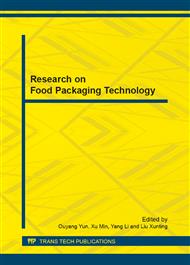p.126
p.130
p.135
p.140
p.148
p.152
p.156
p.162
p.167
Research on Fracture Surface Morphology and Tensile Properties of Cellulose-Based Green Food Packaging Membrane Materials
Abstract:
The Green food-packaging membranes were prepared with N-methylmorpholine-N-oxide (NMMO) as the major solvent by using L-S phase inversion technique. Scanning electron microscopy (SEM) was adopted to characterize fracture surface morphology of membrane, and tensile machine was adopted to test the membrane strength performance. Research results show with the concentration of cellulose increases from 5% to 9%, structure of membrane becomes compact, aperture size becomes small and even, value of tensile strength increases 59.6%, and value of elongation increases 67.5%. With dissolving temperature increases from 100°C to 120°C, structure of membrane becomes loose, pore size becomes big and uneven, value of tensile strength decreases 19.2%, and value of elongation decreases 13.1%. The research can provide the theoretical reference for optimizing technology, adjusting the structure of membrane, and improving the performances of membrane.
Info:
Periodical:
Pages:
148-151
Citation:
Online since:
November 2013
Authors:
Price:
Сopyright:
© 2014 Trans Tech Publications Ltd. All Rights Reserved
Share:
Citation:


